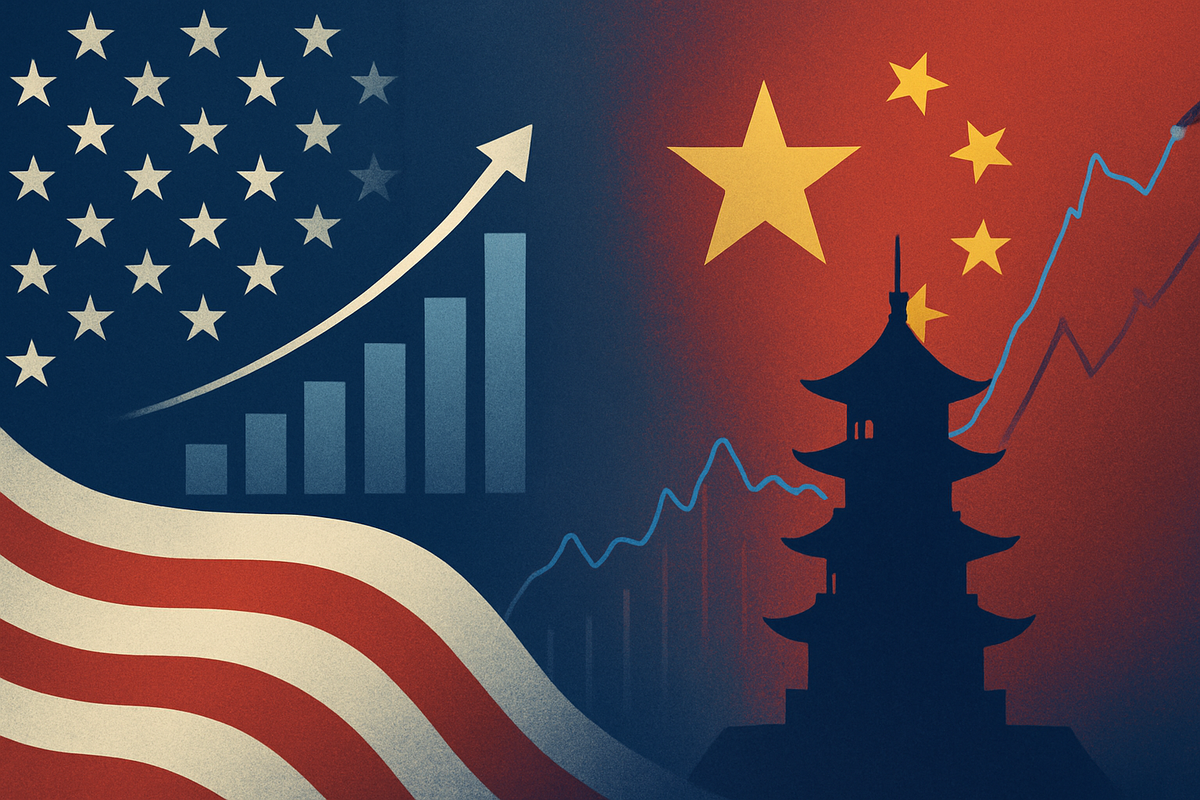
Global financial markets are experiencing a delicate dance between escalating trade tensions and a glimmer of hope for de-escalation between the United States and China. As of October 2025, despite a backdrop of renewed tariff threats and export controls, a recent shift towards a more conciliatory tone from Washington and the anticipation of high-level diplomatic engagements have injected a cautious optimism, leading to a tentative relief rally in equities worldwide. Investors are closely monitoring every development, weighing the risks of a full-blown trade war against the potential for a breakthrough that could stabilize global commerce.
The immediate implications are a blend of volatility and speculative gains. While initial reports of expanded Chinese export controls and reciprocal US tariff threats triggered a "risk-off" sentiment, prompting a sell-off in technology stocks and a dip in oil prices, subsequent signals of potential dialogue between President Trump and President Xi Jinping have reversed some of these losses. This market rebound underscores the profound impact that the US-China trade relationship continues to have on investor confidence and the broader economic outlook, even as the fundamental friction remains unresolved.
The Shifting Sands of Geopolitical Commerce
The current state of US-China trade relations in October 2025 is a complex tapestry woven with threads of confrontation and negotiation. Just ahead of the November 10 expiration of a previous trade truce, which had set tariffs at 30% on Chinese goods and 10% on US goods, both nations have engaged in a high-stakes game of brinkmanship. Early October saw China (SHA: 601398) expand its export controls on critical minerals, a move swiftly met by threats from the US President to impose 100% tariffs on Chinese goods and implement new export controls on critical software, effective November 1. Without an extension of the existing truce, potential US tariffs on Chinese goods could skyrocket to 145%.
This latest escalation transcends traditional tariffs, encompassing targeted entity sanctions, stringent export controls on advanced technologies like semiconductors, and new fees, such as port fees on commercial ships. This multifaceted approach highlights a deepening geostrategic and military competition that permeates economic policy. However, amidst these aggressive postures, analysts widely interpret these actions as "negotiation theatre," tactics designed to strengthen bargaining positions ahead of an anticipated meeting between President Trump and President Xi Jinping at the APEC forum in South Korea later this month. Crucially, the US administration has recently adopted a more conciliatory tone, with President Trump suggesting that a resolution is possible and that the US aims to "help China, not hurt it."
Initial market reactions to the renewed flare-up were predictably negative. US equities experienced a notable sell-off, with technology stocks particularly hard hit, marking the worst day for US shares since April. During this period of heightened anxiety, safe-haven assets like gold maintained high prices, while cryptocurrencies such as Bitcoin (COIN: BTC) saw declines. Oil prices also tumbled, reflecting concerns about global demand in the face of escalating trade friction. However, the subsequent shift in tone from the US administration and the anticipation of a potential Trump-Xi meeting injected a degree of optimism, leading to a stabilization and partial rebound. US equity futures rose, the dollar slightly eased, and Asian stock markets reacted positively, with Chinese shares in Hong Kong (HKEX: 388) climbing and nearing a bull market. European shares also advanced, and oil prices, which had hit five-month lows, rebounded on hopes of de-escalation.
Despite this tentative rally, market volatility is expected to persist until concrete progress emerges from ongoing negotiations. The looming threat of additional US tariffs on Chinese goods could still weigh heavily on technology stocks and broader equities in both countries, maintaining an environment of elevated stock market uncertainty. The global economy has already absorbed significant losses from existing tensions, with reduced import volumes, distorted bilateral trade patterns, and increased consumer costs in the US. The ongoing uncertainty continues to push companies towards supply chain diversification, seeking to mitigate future risks.
Corporate Fortunes in the Balance
The ebb and flow of US-China trade tensions directly impact the fortunes of numerous public companies, creating both potential winners and losers depending on their exposure and strategic agility. In an environment where easing tensions are hoped for, rather than definitively realized, companies with significant supply chain or market presence in both countries stand to gain the most from any de-escalation.
Technology companies, particularly those involved in semiconductor manufacturing and software, are highly sensitive to trade relations. Firms like Apple (NASDAQ: AAPL), which relies heavily on Chinese manufacturing for its products and the Chinese market for a substantial portion of its sales, would breathe a sigh of relief. Easing tensions could reduce the risk of tariffs on components or finished goods, stabilize supply chains, and bolster consumer confidence in key markets. Similarly, chipmakers such as Qualcomm (NASDAQ: QCOM) and Intel (NASDAQ: INTC), which supply to Chinese tech giants, would benefit from a more predictable trade environment, potentially leading to increased sales and fewer licensing hurdles. Conversely, continued escalation, particularly involving export controls on critical software or technology, could severely disrupt their operations and profitability.
Beyond technology, companies in the agricultural sector, like Archer-Daniels-Midland (NYSE: ADM) and Bunge (NYSE: BG), often suffer disproportionately from trade disputes as China is a major importer of US agricultural products. Any reduction in tariffs or trade barriers would likely lead to increased demand and better pricing for American farmers and agribusinesses. Manufacturing companies with intricate global supply chains, such as General Motors (NYSE: GM) and Boeing (NYSE: BA), also stand to gain from a more stable trade relationship. Reduced tariffs on components and finished goods would lower production costs and improve market access, potentially boosting sales in one of the world's largest consumer markets.
However, companies that have benefited from the previous protectionist environment, perhaps by relocating production or finding alternative suppliers, might face new competitive pressures if tariffs are significantly reduced. Furthermore, the ongoing push for supply chain diversification means that even with an easing of tensions, many companies will continue to de-risk their operations by reducing over-reliance on a single country, whether it be China or the US. This strategic pivot, while beneficial for long-term resilience, represents a significant investment and operational shift for many firms.
Broader Implications and Historical Parallels
The current state of US-China trade relations, oscillating between threats and tentative dialogue, fits into a broader industry trend of increasing geopolitical influence on global commerce. The push for supply chain resilience and diversification, initially spurred by the COVID-19 pandemic, has been significantly accelerated by the enduring trade friction. Companies are no longer solely focused on cost efficiency but are now prioritizing security and redundancy, leading to a re-evaluation of global manufacturing footprints and sourcing strategies. This trend has ripple effects on competitors and partners, as companies in "bystander" economies, particularly in Southeast Asia and Mexico, have seen increased investment and export opportunities as firms seek alternative production hubs.
Regulatory and policy implications are substantial. The ongoing tensions highlight the potential for governments to wield economic tools—tariffs, export controls, sanctions—as instruments of foreign policy, transforming trade from purely commercial exchanges into strategic leverage. This dynamic could lead to more fragmented global trade rules and a more complex operating environment for multinational corporations. The World Trade Organization (WTO) has already forecasted a sluggish global trade growth of merely 0.5% next year, partly attributing this slowdown to the lingering effects of US tariffs, underscoring the systemic impact of these disputes. Furthermore, the inflationary pressures in the US, partly exacerbated by tariffs, could influence the Federal Reserve's stance on interest rate policies, potentially delaying or altering anticipated rate cuts.
Historically, trade disputes between major economic powers are not new, but the scale and technological focus of the US-China rivalry present unique challenges. Comparisons can be drawn to the US-Japan trade wars of the 1980s, where disputes over automobiles and electronics led to voluntary export restraints and managed trade agreements. However, the current US-China context is complicated by a deeper ideological and strategic competition, particularly concerning technological supremacy and national security, making a swift and comprehensive resolution more challenging. The concept of "decoupling" or "de-risking" in critical sectors like semiconductors and AI signifies a more profound shift than previous trade spats.
The Path Ahead: Navigating Uncertainty
Looking ahead, the short-term future of US-China trade relations hinges critically on the outcome of the anticipated meeting between President Trump and President Xi Jinping at the APEC forum. A successful dialogue, even if it yields only a temporary truce or a framework for future negotiations, could provide a much-needed boost to market confidence and stave off the immediate threat of heightened tariffs. Conversely, a failure to make progress could plunge markets back into a "risk-off" scenario, intensifying the current trade war and potentially triggering a broader economic slowdown.
In the long term, companies will need to continue adapting to a more fragmented and politicized global trade environment. Strategic pivots towards diversified supply chains, regionalized manufacturing, and enhanced geopolitical risk assessment will become even more critical. Companies like Tesla (NASDAQ: TSLA), which has significant manufacturing and sales operations in China, may need to carefully balance their global strategies to mitigate risks from potential trade barriers while capitalizing on growth opportunities. Similarly, raw material suppliers and logistics companies will need to remain agile, ready to reroute supply lines and adjust pricing based on evolving trade policies.
Market opportunities may emerge in sectors that benefit from reshoring or nearshoring initiatives, as well as in countries that become alternative manufacturing hubs. Challenges will persist for companies heavily reliant on cross-border trade in sensitive technologies or products subject to frequent tariff changes. Potential scenarios range from a "managed competition" where both sides agree to a stable, albeit competitive, trade framework, to a full-blown economic decoupling that reshapes global commerce for decades. Investors should prepare for continued volatility and prioritize companies with strong balance sheets, diversified operations, and adaptable business models.
A Cautious Outlook Amidst Lingering Tensions
The recent market rally, sparked by a hopeful shift in diplomatic tone, serves as a powerful reminder of the deep desire for stability in US-China trade relations. While the immediate threat of escalating tariffs has been momentarily tempered by the prospect of high-level talks, the underlying reality is one of enduring friction and strategic competition. The tentative optimism in the market reflects a fragile hope for de-escalation rather than a definitive easing of tensions.
Moving forward, investors should remain vigilant. The outcome of the upcoming APEC meeting will be a critical determinant of short-term market direction. A successful outcome could lead to further market gains, particularly for companies with significant exposure to both economies. However, any lack of progress or renewed aggressive rhetoric could quickly reverse these gains. The broader trend of supply chain diversification and the use of economic policy as a geopolitical tool will continue to shape the global business landscape.
In the coming months, investors should closely watch for concrete actions rather than just rhetoric. Specifics of any potential trade agreements, changes in tariff structures, and the enforcement of export controls will be key indicators. Companies that demonstrate resilience through diversified operations, innovative product offerings, and strong government relations will be best positioned to navigate this complex environment. The path ahead is fraught with uncertainty, yet the market's reaction to even a hint of de-escalation underscores the immense value placed on a more harmonious, or at least predictable, US-China trade relationship.
This content is intended for informational purposes only and is not financial advice







